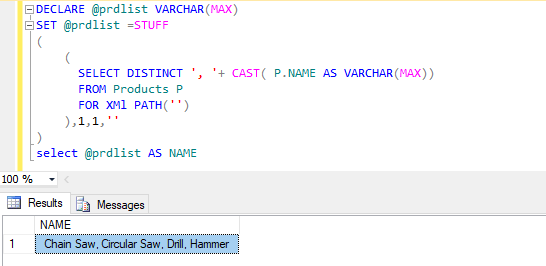 |
| Comma Separated Values in SQL |
Predominantly in reporting, you may gone through a situation where you need to convert a comma separated values into list of rows or to convert a list of rows into single column to display in a report. In this splash reading, you will understand the following:
- How to convert comma separated data in a column to multiple rows
- How to convert multiple rows into one comma separated values
- Using COALESCE function
- Using STUFF function
Convert comma separated data in a column to multiple rows
Here we have an Customer table with a list of products bought by each customer,
Suppose you want to return this as a single table, list of products bought by each customer. we need to create a function that splits our comma separated columns into rows like you can see below,
| ID | CUSTOMER | PRODUCTS |
|---|---|---|
| 1 | Stuart | Chain Saw,Circular Saw |
| 2 | Michael | Drill,Hammer |
| 3 | Jonathan | Sticky Notes,Mouse |
| 4 | Nabeel | Mobile,Headset |
CREATE FUNCTION [dbo].[SplitString]
(
@Input NVARCHAR(MAX),
@Character CHAR(1)
)
RETURNS @Output TABLE (
Item NVARCHAR(1000)
)
AS
BEGIN
DECLARE @StartIndex INT, @EndIndex INT
SET @StartIndex = 1
IF SUBSTRING(@Input, LEN(@Input) - 1, LEN(@Input)) <> @Character
BEGIN
SET @Input = @Input + @Character
END
WHILE CHARINDEX(@Character, @Input) > 0
BEGIN
SET @EndIndex = CHARINDEX(@Character, @Input)
INSERT INTO @Output(Item)
SELECT SUBSTRING(@Input, @StartIndex, @EndIndex - 1)
SET @Input = SUBSTRING(@Input, @EndIndex + 1, LEN(@Input))
END
RETURN
END
(
@Input NVARCHAR(MAX),
@Character CHAR(1)
)
RETURNS @Output TABLE (
Item NVARCHAR(1000)
)
AS
BEGIN
DECLARE @StartIndex INT, @EndIndex INT
SET @StartIndex = 1
IF SUBSTRING(@Input, LEN(@Input) - 1, LEN(@Input)) <> @Character
BEGIN
SET @Input = @Input + @Character
END
WHILE CHARINDEX(@Character, @Input) > 0
BEGIN
SET @EndIndex = CHARINDEX(@Character, @Input)
INSERT INTO @Output(Item)
SELECT SUBSTRING(@Input, @StartIndex, @EndIndex - 1)
SET @Input = SUBSTRING(@Input, @EndIndex + 1, LEN(@Input))
END
RETURN
END
Now, we have created our function to split our columns we need to provide two inputs one is comma separated column values and other one is our separate string comma. This function identifies the comma using CHARINDEX and splits the values using SUBSTRING and inputs into a new row as an Item that will be returned in our select statement. Lets put this function into action,
How to use this function in a select statement?
The above statement, retrieves the products based on customer using our SplitString function, the cross apply function used to join a table to a table-valued function is evoked for each row returned from the table. Lets see how the outputs will look like?
The T-SQL now has STRING_SPLIT() function that makes this type of operation very easy. This function was first available in SQL Server 2016. There is no need to create our customized function like we created before we can simply replace that SplitString into STRING_SPLIT this might work it out. But this STRING_SPLIT has a compatibility level that you can see here in the Microsoft documentation. The syntax for using STRING_SPLIT() function is,
The returned output will look like this,
Convert multiple rows into one comma-separated values
To convert multiple rows into one comma-separated values, we can use two methods one is using COALESCE function and the other one is using the STUFF function. Suppose if we have products table like below,
Using COALESCE Function
The COALESCE function in SQL returns first the first non-NULL expression among its arguments.
This statement returns the list of rows into a single comma-separated values like you see below,
Using STUFF Function
The STUFF function inserts a string into another string. It deletes a specified length of characters in the first string at the start position and then inserts the second string into the first string at the start position.
This statement returned output is as follows,
If you like to learn more about STUFF function, you can go through the Microsoft documentation here.






Comments
Melbourne Web Developer